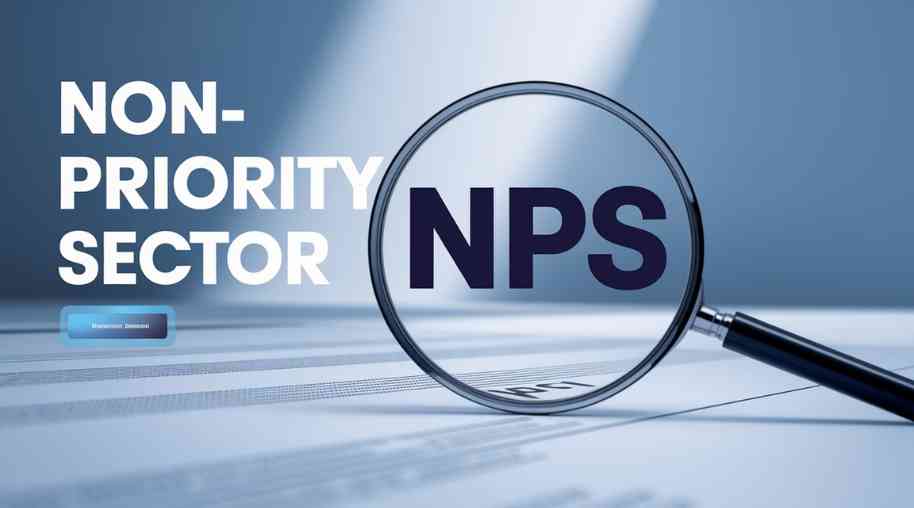NPS Full Form-Non-Priority Sector
by Shashi Gaherwar
0 1018
Non-Priority Sector Lending: Understanding Its Role and Impact in Banking
In the banking sector, loans and advances are classified into two major categories: Priority Sector Lending (PSL) and Non-Priority Sector Lending (NPSL). While priority sector lending refers to loans directed toward sectors crucial for economic and social development, the non-priority sector comprises areas that do not fall under this mandated classification. Despite receiving less regulatory attention, non-priority sector lending plays a significant role in the financial ecosystem. This article delves into the concept of non-priority sector lending, its components, impact on banks, and overall economic significance.

What is Non-Priority Sector Lending?
Non-Priority Sector Lending (NPSL) refers to the loans and financial assistance provided to sectors that are not included under the Reserve Bank of India’s (RBI) priority sector guidelines. Unlike priority sector lending, which mandates a certain percentage of bank credit to be directed toward sectors like agriculture, MSMEs, education, and housing, non-priority sector lending encompasses sectors such as:
• Large-scale industries and corporate loans
• Real estate and infrastructure projects (beyond PSL limits)
• Consumer loans, including personal and vehicle loans
• Investment and trading activities
• Luxury goods and high-value consumption sectors
Banks and financial institutions allocate credit to these sectors based on commercial viability, risk assessment, and profitability rather than regulatory mandates.
Key Features of Non-Priority Sector Lending
1. Market-Driven Credit Allocation – Unlike PSL, which is regulatory-driven, NPSL is primarily based on the bank’s discretion and market demand.
2. Higher Interest Rates – Loans under NPSL generally attract higher interest rates due to the associated risks and the absence of regulatory caps.
3. Profit Maximization – Banks focus on sectors with higher returns, making NPSL an essential component of their profitability strategy.
4. Lower Default Risk in Certain Segments – Established corporations and high-net-worth individuals (HNIs) often avail NPSL loans, reducing default risk compared to some PSL categories.
5. No Minimum Lending Requirements – Unlike PSL, banks are not mandated to allocate a fixed percentage of their credit to NPSL sectors.
Sectors Covered Under Non-Priority Sector Lending
1. Corporate and Large Business Loans
One of the primary beneficiaries of non-priority sector lending is the corporate sector, which requires large-scale funding for expansion, working capital, and mergers & acquisitions.
2. Real Estate and Luxury Housing
High-value real estate projects and luxury housing developments that exceed PSL limits fall under NPSL. These projects are often funded by private banks and financial institutions.
3. Personal and Consumer Loans
Loans for personal needs, such as high-end consumer durables, foreign travel, and luxury vehicles, come under NPSL. These loans are widely used by salaried individuals and business owners.
4. Infrastructure Projects Beyond PSL Limits
While certain infrastructure projects qualify under PSL, large-scale projects in power, highways, and telecommunications often require funding beyond PSL limits, making them part of NPSL.
5. Investment and Trading Activities
Banks provide loans for investment in capital markets, trading businesses, and commercial ventures, which do not fall under PSL but contribute to economic growth.
Impact of Non-Priority Sector Lending on Banks and Economy
1. Profitability and Revenue Generation
Non-priority sector lending is a major revenue stream for banks, as it allows them to charge higher interest rates compared to PSL loans, where rates are often regulated.
2. Credit Growth and Market Expansion
By lending to large businesses, infrastructure projects, and high-income consumers, banks contribute to economic expansion and industrial development.
3. Risk Management and Loan Defaults
Since NPSL does not receive the same policy support as PSL, banks face higher risks of defaults, especially in volatile sectors like real estate and investment.
4. Economic Diversification
NPSL enables economic diversification by supporting non-agricultural industries, consumer spending, and commercial infrastructure, leading to balanced economic growth.
5. Competitive Banking Environment
Banks actively compete in the non-priority lending space to offer customized financial products, leading to innovation in lending solutions and customer-centric banking services.
Challenges in Non-Priority Sector Lending
1. Higher Risk of Bad Loans
Corporate loans and real estate financing under NPSL have historically contributed to non-performing assets (NPAs) due to economic slowdowns and market fluctuations.
2. Economic Uncertainty
Unlike PSL, which benefits from government support, NPSL sectors are more exposed to economic downturns, affecting repayment rates and financial stability.
3. Regulatory Changes and Compliance
Although NPSL does not have stringent regulatory requirements like PSL, changes in monetary policies, taxation, and sectoral guidelines can impact its profitability.
4. Limited Support for Small Borrowers
Since NPSL is focused on high-value lending, smaller borrowers often face difficulties accessing funds due to strict creditworthiness criteria.
Balancing Priority and Non-Priority Sector Lending
For a stable financial system, banks must strike a balance between PSL and NPSL. While PSL ensures inclusive economic growth, NPSL drives corporate expansion, infrastructure development, and consumer financing. Banks adopt the following strategies to manage this balance:
1. Diversifying Loan Portfolios – Banks distribute their credit exposure across PSL and NPSL to mitigate risks.
2. Risk-Based Pricing – Higher risk loans under NPSL come with increased interest rates, helping banks manage potential defaults.
3. Monitoring and Credit Evaluation – Advanced credit assessment tools help banks minimize NPA risks in NPSL sectors.
4. Regulatory Compliance – While PSL is mandatory, banks align NPSL strategies with RBI’s monetary policies to ensure financial stability.
Non-Priority Sector Lending (NPSL) is a crucial component of the banking industry, contributing to profitability, corporate financing, and infrastructure development. While it lacks regulatory mandates like PSL, it provides banks with the flexibility to allocate credit based on economic demand and market opportunities. However, due to its exposure to financial risks and economic uncertainties, careful risk management, credit assessment, and strategic diversification are essential for sustainable growth in NPSL. By maintaining a balance between priority and non-priority lending, banks can foster economic development while ensuring financial stability and growth.

Share:








Comments
Waiting for your comments